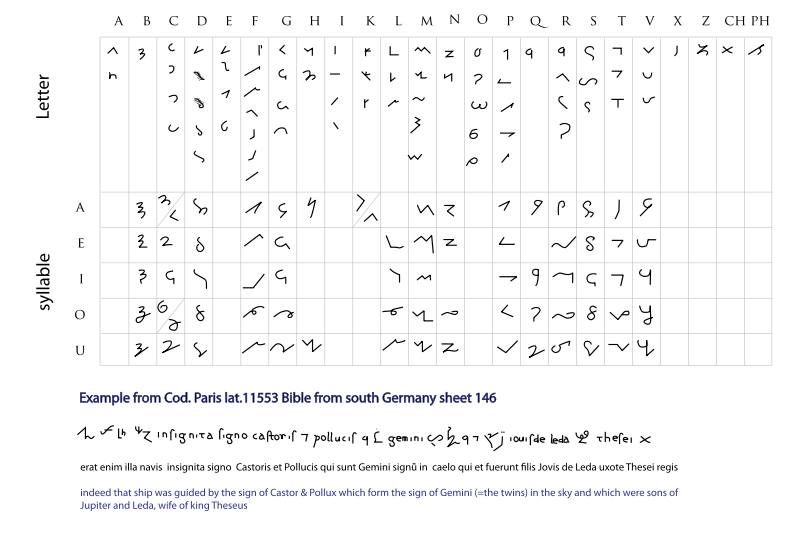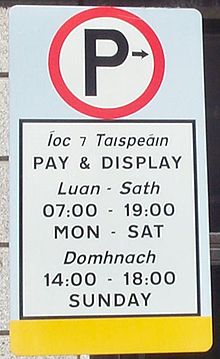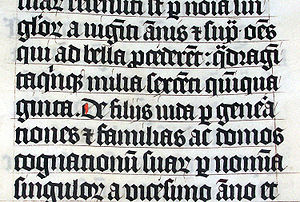- Tironian notes
-
Tironian notes Type printed semi-syllabic shorthand Languages Latin Creator Marcu Tullius Tiro Created 60s BCE Time period 1st century BCE-16th century ACE Status some Tironian symbols still in modern use Unicode range Et: U+204A; MUFI Note: This page may contain IPA phonetic symbols. Tironian notes (notae Tironianae) is a system of shorthand said to have been invented by Cicero's scribe Marcus Tullius Tiro. Tiro's system consisted of about 4,000 signs,[citation needed] somewhat extended in classical times to 5,000 signs. In the European Medieval period, Tironian notes were taught in monasteries and the system was extended to about 13,000 signs (see scribal abbreviations).[1] The use of Tironian notes declined after 1100 but some use can still be seen through the 17th century.[2][3]
Contents
Note on sign counts
 Tironian et, U+204A "⁊".
Tironian et, U+204A "⁊".Notae can be themselves composites (ligatures) of simpler notae, the resulting compound still being far shorter than the word it replaces. This accounts in part for the large number of attested notae, and for the wide variation in estimates of the total number of notae. Further, the "same" sign can have multiple variant forms, leading to the same issue. (See external link for examples.)
History
The earliest western shorthand system known to us is that employed by the Greek historian, Xenophon in the memoir of Socrates, called notae socratae.
The first report of the usage of tironian notes is by Plutarch who notes that in 63 BC it was used to record Cato's denunciation against Catiline:- This only of all Cato's speeches, it is said, was preserved; for Cicero, the consul, had disposed in various parts of the senate-house, several of the most expert and rapid writers, whom he had taught to make figures comprising numerous words in a few short strokes; as up to that time they had not used those we call shorthand writers, who then, as it is said, established the first example of the art.[4]
Dio Cassius attributes to Maecenas the invention of shorthand, and states that he employed his freedman Aquila in teaching the system to numerous others.[5]
Isidore of Seville, however, details another version of the early history of the system,[6] ascribing the invention of the art to Quintus Ennius, who he says invented 1100 marks (Latin: notae). Isidore states that Tiro brought the practice to Rome, but only used notae for prepositions. Isidore tells of the development of additional notae by various hands, viz., Vipsanius, "Philargius", and Aquila (as above), until Seneca systematized the various marks to approximately 5000 notae.
In the Middle Ages, notae to represent words were widely used in conjunction with other scribal abbreviations and the initial symbols were expanded to 14,000 by the Carolingians; but the stenographic alphabet notation had a "murky existence" (C. Burnett) as it was often associated with witchcraft and magic, and was forgotten until interest was rekindled by the Thomas Beckett, archbishop of Canterbury, in the 12th century. In the 15th century Johannes Trithemius, abbot of the Benedictine abbey of Sponheim, discovered the notae Benenses: a psalm and a Ciceronian lexicon written in Tironian shorthand.[7]
 Example of tironian letter which can be modified with various marks to form more complex notes. Some glyphs may be identical for different letters. In the text example due to evolution of writing (separate from notes) there are no capital letters, letter s appears as a long s, st is a ligature and there are no dot on i.
Example of tironian letter which can be modified with various marks to form more complex notes. Some glyphs may be identical for different letters. In the text example due to evolution of writing (separate from notes) there are no capital letters, letter s appears as a long s, st is a ligature and there are no dot on i.
Current
 A pay and display sign in Dublin with the Tironian et for the Irish agus ("and").
A pay and display sign in Dublin with the Tironian et for the Irish agus ("and").
Tironian notes are still used today, particularly, the Tironian "et", used in Ireland to mean 'and' – also used elsewhere in blackletter texts as late as 1821 – and in the "z" of "viz." (for 'et' in videlicet).
The Tironian "et" can look very similar to an "r rotunda" (ꝛ), depending on the typeface.
In Old English Manuscripts, the Tironian "et" served as both a sonic and morphological place holder. For instance a Tironian "et" between two words would be phonetically pronounced "ond" and would mean "and". However if the Tironian "et" followed the letter "s", then it would be phonetically pronounced "sond" and mean water (cognate with English sound). This additional function of a phonetic as well as a conjunction place holder has escaped formal Modern English; for example, one may not spell the word "sand" as "s&" (although this occurs in an informal style practised on certain internet forums). However, "&c." for "etc." is still seen in handwriting and books.
Support on computers
The possibilities to use Tironian notes on modern computers are very limited. The Tironian et ("and") ⁊ is available at Unicode point U+204A. A number of other Tironian signs have been assigned to the Private Use Area of Unicode by the Medieval Unicode Font Initiative (MUFI) who also provide links to free typefaces that support their specifications.
Some applications (for example the Scottish Gaelic localisation of Firefox and Opera) use the box-drawing character U+2015 ┐ instead as it displays widely.
Gallery
See also
References
- ^ Guénin, Louis-Prosper; Guénin, Eugène (1908) (in French), Histoire de la sténographie dans l'antiquité et au moyen-âge; les notes tironiennes, Paris, Hachette et cie, OCLC 301255530
- ^ Mitzschke, Paul Gottfried; Lipsius, Justus; Heffley, Norman P (1882), Biography of the father of stenography, Marcus Tullius Tiro. Together with the Latin letter, "De notis", concerning the origin of shorthand, Brooklyn, N.Y, OCLC 11943552
- ^ Kopp, Ulrich Friedrich; Bischoff, Bernhard (1965) (in German), Lexicon Tironianum, Osnabrück, Zeller, OCLC 2996309
- ^ Plutarch. "Cato the Younger." Lives. John Dryden, translator.
- ^ Dio Cassius. Roman History. 55.7.6
- ^ Isidorus. Etymologiae or Originum I.21ff, Gothofred, editor
- ^ David A. King, The ciphers of the monks: a forgotten number-notation of the Middle Ages
External links
- Karl Eberhard Henke: Über Tironische Noten Manuscript B 16 of the "Bibliothek der Monumenta Germaniae Historica", c. 1960 (German) (See 33. within for examples of composite notae.)
Categories:- Shorthand systems
- Ancient Rome
- Typography
- Uncommon Latin letters
Wikimedia Foundation. 2010.



